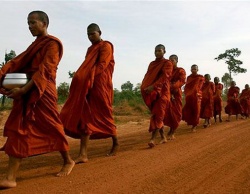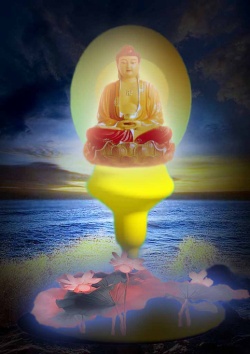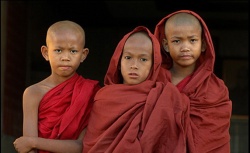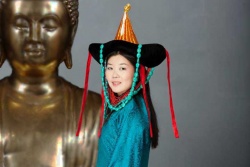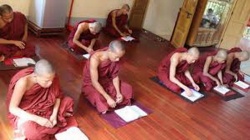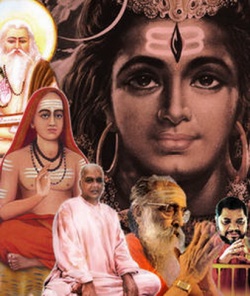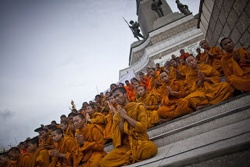Iconography of the Buddha
The image of the Buddha is distinguished in various different ways. The Buddha is usually shown in a stylised pose or asana. Also important are the 32 lakshanas or special bodily features.
Lakshanas
Some of these symbolise aspects of the Buddha's spiritual character whilst others draw attention to the concept that his beautiful and perfectly proportioned body is an outer reflection of inner spiritual power. These are drawn from the ancient Indian concept of the Mahapurusha or 'Cosmic Being'.
Well-placed flat-footed feet
Mark of the Wheel of Law on soles of feet or palms of hands
Soles and palms more tender and soft than in most people
Long toes and fingers
Webbed fingers and toes
Feet well set on the ground
Ankle bones that are hardly noticeable
Lower legs like those of an antelope
Body frame tall and straight
Arms that reach to the knees when standing
Genitalia withdrawn
Hairs on the head and arranged in soft curls that point to the right
Hairs of the body point upwards.
Skin smooth and delicate
Skin golden. (According to legend the Buddha was born with limbs that shone like the sun)
Seven special features:
2 broad heels
2 broad hands
2 broad shoulderblades
Broad neck
Torso like a lion
Shoulders gently curved
Chest wide
Body circumference has proportions of a fig tree
Cheeks like a lion
40 teeth rather than the normal 32
Teeth have no gaps
Teeth are equal in size
Very white teeth
An excellent sense of taste
A long tongue that can reach his ears
A strong and attractive voice like that of the Hindu god Brahma
Eyes the colour of sapphire
Long eyelashes
Tuft of hair or third eye between his eyebrows (urna). This symbolises spiritual insight
A bump on the top of the head known as ushnisha which symbolises wisdom and spirituality and his attainment of enlightenment.
Other symbols regularly found in images of the Buddha include:
Elongated ears
One feature that is regularly used but is not considered a Lakshana is showing the Buddha with elongated earlobes: these are to remind us that the Buddha was once a prince who wore a great deal of jewellery including heavy earrings which stretched out his earlobes. Although he gave up the wearing of any jewellery when he gave up his life of luxury, his earlobes remained elongated.
Lotus flowers
Lotus flowers often appear in images of the Buddha. It is a symbol of things which are pure and good.A lotus is a flower that begins its life in the mud at the bottom of a pond and then rises to the surface to flower. It therefore reminds people that in the same way, people can rise above their problems and achieve enlightenment.
The Wheel of Law
The Wheel of Law can sometimes be found marked on the soles of the Buddha's feet and the palms of his hand. It has eight spokes to remind followers that the Buddha taught of the Noble Eightfold Path which outlined eight ways of living. The Wheel itself is a reminder of the cycle of birth, death and rebirth.
In addition, the hand gestures or mudras of the Buddha all have particular meanings. Most symbolise a major event in the Buddha's life, such as his attainment of enlightenment or his first sermon, while others represent a characteristic act such as giving of charity or of reassurance to his followers.
Mudras
The images below show details of the mudras (symbolic gestures) of five of the sculptures from the Museum's collections:
Bhumisparsa, Sakyamuni at point of enlightenment, (Earth Witness). Museum no. IM.227-1920
Bhumisparsa
Sakyamuni at point of enlightenment (Earth Witness)
The Buddha made this gesture, known as Bhumiparsa just before his enlightenment to call the earth Goddess witness to his worthiness to become a Buddha. In response the earth shook and the evil demons of Mara who had been tormenting him fled in terror.
Dharmachakra, Preaching Buddha, Nepal 10th/11th century, (Preaching). Museum no. IS.37-1988
Dharmachakra
Preaching Buddha, Nepal 10th/11th century (Preaching)
This mudra is called Dharmachakra or 'the turning of the Wheel of Law'. It refers to one of the most important moments in the life of the Buddha when he gave his first sermon in the Deer Park at Sarnath.
Abhaya, Standing Buddha, Bihar, 7th century (Reassurance). Museum no. IS.3-2004
Abhaya
Standing Buddha, Bihar, 7th century (Reassurance)
Abhaya means 'no fear' and this mudra shows the Buddha giving reassurance and protection to his followers.
Varada, Bodhisattva Padmapani, Tibet, 13th century, (Giving). Museum no. IM 156-1929
Varada
Bodhisattva Padmapani, Tibet, 13th century (Giving)
Varada symbolises giving and generosity, both important Buddhist virtues.
Dhyana, Meditating Buddha, Eastern India, 10th/11th century (Meditation). Museum no. IS 239-1950
Dhyana
Meditating Buddha, Eastern India, 10th/11th century (Meditation)
Dhyana is the traditional pose of meditation.
Asanas
A Buddha's pose is known as an asana. Buddhas are usually represented either standing, sitting or reclining. When shown standing, he often has one hand raised in blessing and reassurance. When seated he is meditating in the lotus position dhyana. Pictures and images of the Buddha Sayyamuni reclining refer to the end of his life just before he entered Parinirvana.
